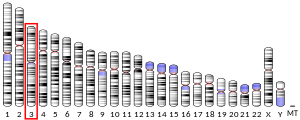CNBP
Ćelijski i protein koji veže nukleinsku kiselinu je protein koji je kod je ljudi kodiran genom CNBP.[5][6][7]
Funkcija
[uredi | uredi izvor]Protein ZNF9 sadrži 7 domena cinkovog prsta i vjeruje se da funkcionira kao RNK-vezujući protein. Ekspanzija CCTG u intronu 1 gena ZNF9 rezultira miotonusnom distrofijom tip 2 (MIM 602668) (upisan u OMIM).[7]
Reference
[uredi | uredi izvor]- ^ a b c GRCh38: Ensembl release 89: ENSG00000169714 - Ensembl, maj 2017
- ^ a b c GRCm38: Ensembl release 89: ENSMUSG00000030057 - Ensembl, maj 2017
- ^ "Human PubMed Reference:". National Center for Biotechnology Information, U.S. National Library of Medicine.
- ^ "Mouse PubMed Reference:". National Center for Biotechnology Information, U.S. National Library of Medicine.
- ^ Lusis AJ, Rajavashisth TB, Klisak I, Heinzmann C, Mohandas T, Sparkes RS (Oct 1990). "Mapping of the gene for CNBP, a finger protein, to human chromosome 3q13.3-q24". Genomics. 8 (2): 411–4. doi:10.1016/0888-7543(90)90303-C. PMID 2249857.
- ^ Liquori CL, Ricker K, Moseley ML, Jacobsen JF, Kress W, Naylor SL, Day JW, Ranum LP (Aug 2001). "Myotonic dystrophy type 2 caused by a CCTG expansion in intron 1 of ZNF9". Science. 293 (5531): 864–7. doi:10.1126/science.1062125. PMID 11486088.
- ^ a b "Entrez Gene: CNBP CCHC-type zinc finger, nucleic acid binding protein".
Dopunska literatura
[uredi | uredi izvor]- Rajavashisth TB, Taylor AK, Andalibi A, Svenson KL, Lusis AJ (Aug 1989). "Identification of a zinc finger protein that binds to the sterol regulatory element". Science. 245 (4918): 640–3. Bibcode:1989Sci...245..640R. doi:10.1126/science.2562787. PMID 2562787.
- Flink IL, Morkin E (Oct 1995). "Organization of the gene encoding cellular nucleic acid-binding protein". Gene. 163 (2): 279–82. doi:10.1016/0378-1119(95)00421-2. PMID 7590281.
- Warden CH, Krisans SK, Purcell-Huynh D, Leete LM, Daluiski A, Diep A, Taylor BA, Lusis AJ (Nov 1994). "Mouse cellular nucleic acid binding proteins: a highly conserved family identified by genetic mapping and sequencing". Genomics. 24 (1): 14–9. doi:10.1006/geno.1994.1576. PMID 7896269.
- Ricker K, Grimm T, Koch MC, Schneider C, Kress W, Reimers CD, Schulte-Mattler W, Mueller-Myhsok B, Toyka KV, Mueller CR (Jan 1999). "Linkage of proximal myotonic myopathy to chromosome 3q". Neurology. 52 (1): 170–1. doi:10.1212/wnl.52.1.170. PMID 9921867.
- McGrath CF, Buckman JS, Gagliardi TD, Bosche WJ, Coren LV, Gorelick RJ (Aug 2003). "Human cellular nucleic acid-binding protein Zn2+ fingers support replication of human immunodeficiency virus type 1 when they are substituted in the nucleocapsid protein". Journal of Virology. 77 (15): 8524–31. doi:10.1128/JVI.77.15.8524-8531.2003. PMC 165261. PMID 12857921.
- Vallo L, Bonifazi E, Borgiani P, Novelli G, Botta A (Feb 2005). "Characterization of a single nucleotide polymorphism in the ZNF9 gene and analysis of association with myotonic dystrophy type II (DM2) in the Italian population". Molecular and Cellular Probes. 19 (1): 71–4. doi:10.1016/j.mcp.2004.09.003. PMID 15652222.
- Botta A, Caldarola S, Vallo L, Bonifazi E, Fruci D, Gullotta F, Massa R, Novelli G, Loreni F (Mar 2006). "Effect of the [CCTG]n repeat expansion on ZNF9 expression in myotonic dystrophy type II (DM2)". Biochimica et Biophysica Acta (BBA) - Molecular Basis of Disease. 1762 (3): 329–34. doi:10.1016/j.bbadis.2005.11.004. PMID 16376058.
- Margolis JM, Schoser BG, Moseley ML, Day JW, Ranum LP (Jun 2006). "DM2 intronic expansions: evidence for CCUG accumulation without flanking sequence or effects on ZNF9 mRNA processing or protein expression". Human Molecular Genetics. 15 (11): 1808–15. doi:10.1093/hmg/ddl103. PMID 16624843.
- Toth C, Dunham C, Suchowersky O, Parboosingh J, Brownell K (Feb 2007). "Unusual clinical, laboratory, and muscle histopathological findings in a family with myotonic dystrophy type 2". Muscle & Nerve. 35 (2): 259–64. doi:10.1002/mus.20685. PMID 17068784.
- Gerbasi VR, Link AJ (Jun 2007). "The myotonic dystrophy type 2 protein ZNF9 is part of an ITAF complex that promotes cap-independent translation" (PDF). Molecular & Cellular Proteomics. 6 (6): 1049–58. doi:10.1074/mcp.M600384-MCP200. PMID 17327219.
- Ewing RM, Chu P, Elisma F, Li H, Taylor P, Climie S, McBroom-Cerajewski L, Robinson MD, O'Connor L, Li M, Taylor R, Dharsee M, Ho Y, Heilbut A, Moore L, Zhang S, Ornatsky O, Bukhman YV, Ethier M, Sheng Y, Vasilescu J, Abu-Farha M, Lambert JP, Duewel HS, Stewart II, Kuehl B, Hogue K, Colwill K, Gladwish K, Muskat B, Kinach R, Adams SL, Moran MF, Morin GB, Topaloglou T, Figeys D (2007). "Large-scale mapping of human protein-protein interactions by mass spectrometry". Molecular Systems Biology. 3 (1): 89. doi:10.1038/msb4100134. PMC 1847948. PMID 17353931.
Vanjski linkovi
[uredi | uredi izvor]- GeneReviews/NCBI/NIH/UW entry on Myotonic Dystrophy Type 2
- ZNF9 protein, human na US National Library of Medicine Medical Subject Headings (MeSH)
- Lokacija ljudskog genoma CNBP i stranica sa detaljima o genu CNBP u UCSC Genome Browseru.




